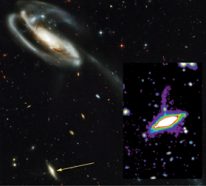Big galaxy swallows little galaxy
Astronomers find a convincing case of a large galaxy caught in the act of eating a smaller one
By Emily Sohn
It’s hard to imagine being so hungry that you’d eat another person. Yet, cannibalism occurs among animals and elsewhere in nature. Even galaxies do it.
Now, scientists have captured one of the best images yet of a distant galaxy in the act of swallowing a smaller neighbor. The discovery supports the theory that galaxies grow by consuming each other.
 |
|
Hubble image shows plumes of stars (purple in inset) being cannibalized by a large spiral galaxy (large white area in inset and arrow in main image). Tadpole galaxy is upper-left in main image. The spiral galaxy and its dwarf satellite lie about 2 billion light-years from Earth. |
| NASA/STScI |
Astronomers have long suspected that it’s a galaxy-eat-galaxy world out there. Many massive galaxies, including our own Milky Way, are surrounded by stellar debris that looks like undigested remnants of smaller star systems.
The most direct evidence yet for that idea comes from an image taken in April 2002 by a new camera on the Hubble Space Telescope.
Australian astronomer Michael Beasley noticed a faint galaxy in the background of the image. Nearby, two star plumes seemed to be coming out of some kind of small blob.
Further analyses and computer simulations revealed that a big galaxy, about the size of the Milky Way, was sucking material, visible as plumes, from a smaller galaxy. The objects are about 2 billion light-years from Earth.
Astronomers think that galaxy cannibalism is common. It’s just hard to see.
Luckily, our own galaxy doesn’t seem to be at risk of getting slurped up. Sometimes, it’s nice to be the biggest kid on the block—at least until we slam into Andromeda, the nearest, large spiral galaxy in our own neighborhood. Then, it’ll be like two big, evenly matched kids battling it out on the schoolyard.







